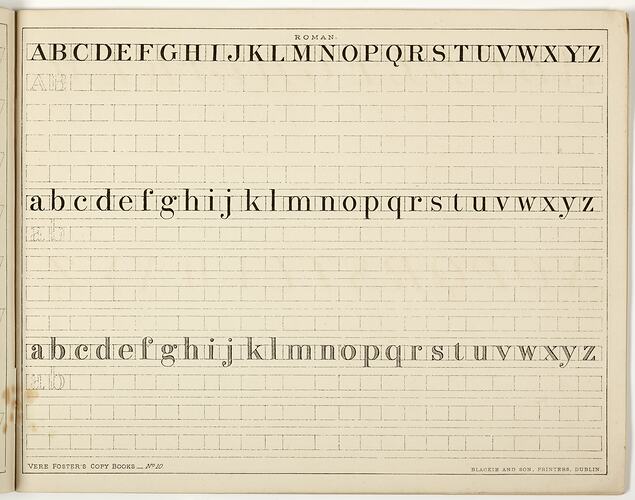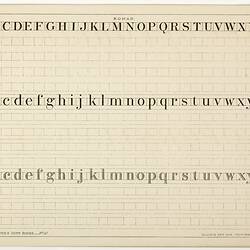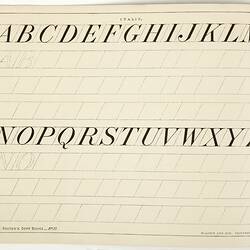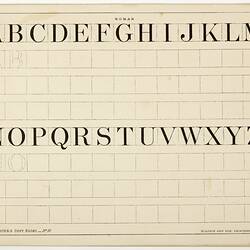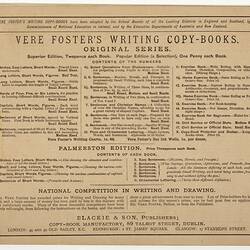Summary
28-page black and white booklet entitled 'Vere Foster's Copy-Books No.10 Ornamental Lettering'. Unused.
Fonts to copy are: Roman and Roman Italic, Egyptian, Engrossing, Old English, German Text, Old English Ornamented, German Text Ornamented, Italic Ornamented, Roman Ornamented, Ornamental, Gothic Initials, Church Text, French, Celtic, and a playful scrip made of human figures. Includes background information about writing and 'Practical Directions'.
Probably printed in the later 19th century, Vere Foster's Copy Books claim to have been 'adopted by the School Boards of all the Leading Districts in England and Scotland, and by the Commissioners of National Education in Ireland.'
Vere Foster (1819-1900) produced a series of copy books from 1865, having first submitted them to eminent educationists, who approved their content. The books were an immediate success, and soon spread through the English-speaking world. Foster, the youngest son of a baron, was initially a benefactor who helped many destitute Irish families to emigrate to America. He took pity on those who were not sufficiently literate to write home to their families, and so devoted himself to improving penmanship (Sassoon, 1999).
This copy book was published by Blackie & Son. Their copy-book manufactory was located at 89 Talbot St, Dublin; the publishers also had branches in London, Edinburgh and Glasgow.
Physical Description
28-page booklet (including cover), printed in black on white (now faded to cream). Cover pages are a darker colour, and feature images of children at play, a border of thistle and other plants, and a shield and scroll at the bottom. Each page features examples of a different type of font, and spaces in which to copy them. The copy book is unused.
Significance
Historical Background:
Part of an eclectic collection that includes ephemera accumulated by the donor's family over the past 100 or so years, as well as provenanced items relating to Ellen Webb and Stanley Hammond, her son-in-law. Ellen Webb was born in Norfolk, England, in 1836, the daughter of an agricultural labourer. At the age of 12 she went into service as a maid. At the age of 20, in 1856, she married her cousin Thomas Webb, by then an Australian settler, who had returned from Australia to marry her. Thomas had done well on the goldfields, and used his earnings to buy a half-share in a schooner. During his visit to England he became qualified as a ship's captain. Captain Webb later became one of the first directors of the shipping company Huddart Parker, and became a rich man.
Thomas and Ellen returned to Australia and lived in Emerald Hill, then in Geelong, and finally at Melville, 32 Middle Crescent Brighton, where they both spent the rest of their days in genteel comfort. Thomas died at the age of 68, in 1898. Ellen outlived him by many years, and was remembered to dress in an old-fashioned manner in later life. She enjoyed handcrafts such as making headpieces. She died at the age of 88, in 1924.
One of their eight children, Ivie Constance, born in 1879, married a neighbour's son, Stanley Hammond (also from Middle Crescent, Brighton). Stanley had attended Melbourne Grammar School, played cricket and tennis, and became a long-term player and official of the Brighton Cricket Club. He went to the Boer War 1900-1901 as a Trooper in 3rd Victorian Contingent, and in 1906 married Ivie. They lived at Carinya in Kensington Road, South Yarra and then at Coonac in Clendon Road, Toorak. They had four daughters: Claire, Joyce, Patricia and Susan. Stanley became a director of British Tobacco Co. (Aust.) Ltd, British-Australasian Tobacco, Co. Pty Ltd; States Tobacco Co. (Aust.) Ltd; and W.D. & H.O. Wills (Aust.) Ltd, Melbourne. Stanley belonged to the Bohemian Club and subsequently The Melbourne Club, and to the Melbourne Cricket Club. He was a Fellow of the Chartered Institute of Secretaries. Ivie died in 1933; Stanley kept working, but retired in 1941. During World War II Coonac was requisitioned by the government for the use of the WAAAFs (Women's Auxiliary Australian Air Force). By this time his daughters had all married and Stanley moved to Trawalla, a boarding house in Toorak. When Trawalla was sold he moved to the Melbourne Club, where he lived until his death in 1958.
Thomas and Ellen's great grand-daughter is the donor of the collection.
More Information
-
Collecting Areas
Clothing & Textiles, Home & Community, Public Life & Institutions
-
Acquisition Information
Donation from Rosalind Wallis, 02 Apr 2009
-
Publisher
Blackie & Son, Great Britain, 1880-1900
Date is circa. -
Inscriptions
Information on other Vere Foster's Writing Copy Books is provided on the rear cover, and details of a national competition in writing and drawing. Inscriptions: Printed on cover: 'VERE FOSTER'S COPY BOOKS / Adopted by / The School Boards of all the Leading Districts in England / and Scotland, and by the Commissioners of National Education in Ireland.' Extensive text follows.
-
Classification
-
Category
-
Discipline
-
Type of item
-
Overall Dimensions
211 mm (Width), 3 mm (Depth), 166 mm (Height)
-
Keywords
